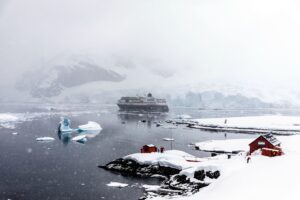Most desolate places in the World.
Most Desolate Places on Earth

From frozen tundras to alpine highlands, some of the most remote places in the world are also the most inhospitable. But from ancient cultures to scientific researchers, there are humans who live in these isolated and barren places. Between eating frozen horse blood and dodging snapping crocodiles, it takes a lot to survive in these harsh environments. Read on to discover six of the most desolate places on the planet.
Ittoqqortoormiit, Greenland
Greenland’s most isolated town has a mere 453 residents,thanks, in part, to its remote location and harsh winters. Located between Northeast Greenland National Park and the glaciers and fjords of Scores by Sound, the town is covered in ice and snow for at least nine months out of the year. Although the terrain is often frozen, the small settlement’s red, green and blue houses brighten the otherwise bleak landscape. Outside of human residents, the area is home to walruses, polar bears, narwhals and reindeer. Planning a trip to Ittoqqortoormiit? Visiting in spring is advised, as the bitter winter conditions are severe. To arrive, one must take three flights on small planes starting from Reykjavik, Iceland, before boarding a helicopter towards the final destination.
Utqiagvik, Alaska
The northernmost town in the United States, Utqiagvik is not connected by a road to the rest of Alaska. Instead, this isolated settlement is only accessible by plane or boat. Transportation within the town is also unique — many locals prefer to use dog sleds over snowmobiles, according to Business insider, due to the difficulty of running a vehicle in the extreme winter temperatures. Perhaps the most unsettling part of life is Utqiagvik is the darkness. The town is so close to the Arctic Circle that residents must endure two months of darkness during the winter. This past year, the sun set on November 18, 2018, and did not rise again until January 23, 2019. Despite the bleak landscape and dark days,Utqiagvik has 4,428 residents who call the seaside city home.
Changtang Plateau, Tibet
Nicknamed the “Roof of the World,” Changtang is a high altitude plateau that stretches nearly 1,000 miles, from Ladakh, India, to northwestern Tibet. The only known residents of these vast and empty highlands are the Changpa, a semi-nomadic pastoral tribe who rely on their herds of goats, sheep and yaks to survive. Life on the Changtang Plateau is harsh, with unpredictable storms during the warmer months and Arctic-like temperatures during the winter. Much of the plateau is protected by The Changtang Wildlife Sanctuary, an organization that endeavors to preserve the wild landscape and the species who call it home.
Kimberley Coast, Australia
The northernmost section of Western Australia is called Kimberley, a region known for its vast and rugged landscape. Largely uninhabited and treacherous to most humans, Kimberley’s coastline and the surrounding outback is as unforgiving as they come. In 1932, two German pilots crash landed on this barren landscape and would have perished had they not been discovered by the local Aboriginal people. In 2017, adventurer Mike Atkinson recreated the German’s plight, putting himself in harm’s way to follow to the same path as the stranded pilots. During his time in the Australian outback, Atkinson managed to survive the lack of food and water, in addition to navigating the dangerous, crocodile-ridden landscape. The last leg of the trip required hiking 40 miles through the bush, all while self-filming the harrowing trek. Luckily, Atkinson is a survival instructor and a wilderness expert — it’s clear that most humans would not be able to live in such a hostile landscape.
Oymyakon, Russia
Dubbed “the coldest village on Earth” by The Washington Post, Oymyakon, Russia, is a grim settlement in the Siberian tundra. With only 500 residents calling this frozen outpost home, wintertime in Oymyakon is bleak. The town’s average temperature in the colder months is -58 degrees Fahrenheit. In 1933, Oymyakon suffered from a cold snap that brought the temperature to a mind-numbing -89 degrees Farenheit, the coldest temperature recorded outside of Antarctica. For the locals, existing in this frigid land is no easy task. The ground is too cold for plumbing, so townspeople must brave the elements to use outhouses. An average meal likely consists of frozen fish, reindeer meat or cubes of iced horse blood, according to wired. A mere 217 miles from the Arctic Circle, the darkest days of the year have three hours of sunlight, making this subzero landscape a very lonely place.
McMurdo Station, Antarctica
The least populated continent on Earth, 98% of Antarctica is covered in ice. As a result, not many people are able to live in such an unforgiving climate. Antarctica’s human population belongs to scientists and researchers stationed throughout the continent. One such place is McMurdo Station, a U.S. Antarctic research facility located on Ross Island. While the station itself has a post office, a chapel, two bars and a golf course, the surrounding icy tundra is uninhabitable. And while the “White Continent” may have many visitors in the summer months, winter is cold, bleak and dark. Out of the 1,200 researchers who live at McMurdo Station in the summer, less than a quarter remain for the winter. With notable effects being depression and disorientation from the harsh and desolate landscape, wintering in Antarctica isn’t appealing in the least.
Source:www.traveltrivia.com

